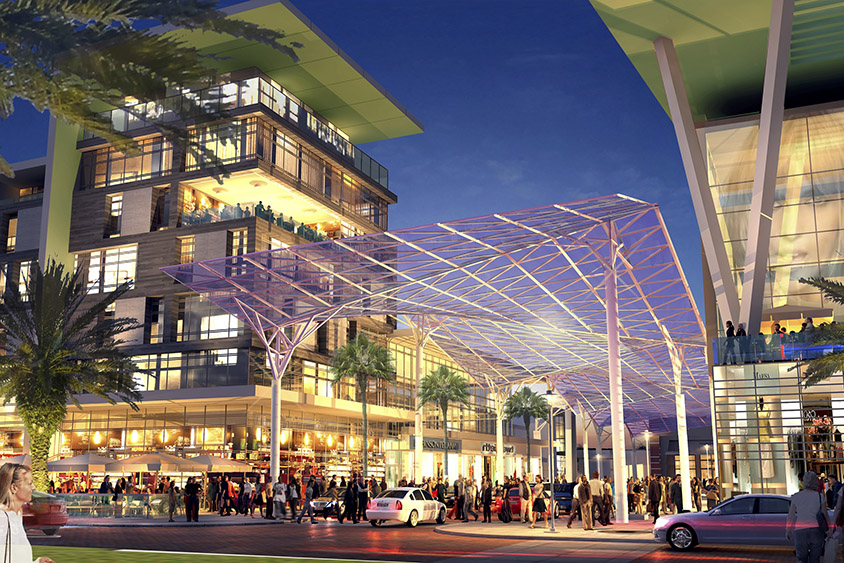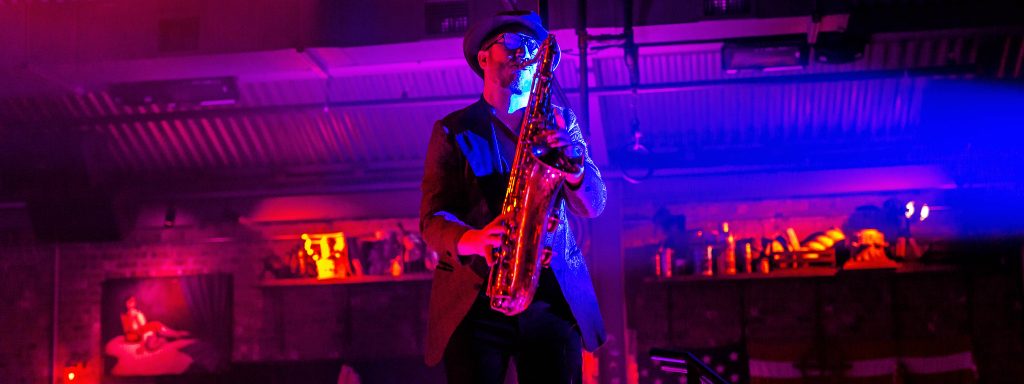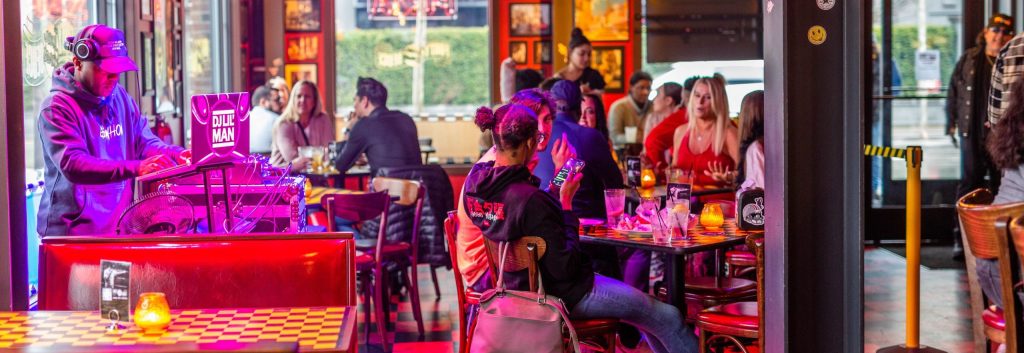By Al Urbanski, Chain Store Age
Leading-edge developers, retailers bring stores to people, not people to store
Look at what the Butler family has wrought in the central Florida crossroads of Gainesville over three-quarters of a century and you see a representative history of brick-and-mortar retail. Starting with a curbside market in the 1930s, Clark Butler expanded to the supermarket format in the ’40s, then surrounded it with the city’s first large-scale shopping center. The original development, known today as Butler North, is a power center fielding Lowe’s and a Walmart Supercenter. The newer Butler Plaza accedes to consumer demands for more upscale eateries and shops such as BurgerFi and a Lilly Pulitzer Signature store.
Now, Clark’s daughter Deborah Butler, president of Butler Enterprises, is working to take the 267-acre retail site to the next level with the Butler Town Center. When completed, it will feature a residential tower, a 365 by Whole Foods and new-to-market retailers. The three-center complex is being re-christened The Neighborhoods at Butler.
Developers have stopped building malls and started making places. Consumers who can buy anything they desire using the little computers in their pockets no longer have to drive to the mall for a new dress, sofa or TV. At the same time, Americans are becoming more urban and they will walk to stores if they are in their neighborhoods. That’s exactly what forward-thinking retailers and developers like Deborah are doing. Not building big parking lots as magnets for cars, but building communities that are magnets for people. Not putting up malls, but putting up homes and offices and restaurants and, of course, retail. They are the new town and neighborhood builders.
In the case of Butler Enterprises, heretofore solely a retail developer, residential space goes hand-in-hand with carefully curated retail that offers up something new to the community at large.
“We cater to a huge trade area,” Deborah said. “Gainesville is the hub of north central Florida, and people come from miles around to work, shop and play.”
The University of Florida and a world-class medical complex that borders the Butler property employ about 100,000 professional and skilled workers who are demanding expanded living and shopping options.
“People have money to spend; now they have to drive to Orlando or Atlanta for fashion selections,” Deborah said. “When Butler Town Center opens, they’ll have a choice closer to home.”
In Morrisville, N.C., within the Raleigh-Durham-Chapel Hill triangle, CASTO is about to finish the fourth phase of Park West Village, a 100-acre, mixed-use development that brings urban-style living and shopping to an educated populace whose household incomes average $107,000. The Bristol offers 250 residences ranging from urban flats to carriage homes, District Lofts adds 100 luxury apartments and The Station will add another 189 urban-style apartments to the development when it opens next year.
“Park West Village has really become a community-within-a-community where tenants and management collaborate to create unique experiences for shopping center visitors and residents,” said Shannon Dixon, executive VP of development and leasing for CASTO’s Southeast division.
The recently completed District Lofts, with fashion-focused stores on the ground level and loft-style apartments above, quickly proved the value of mixed-use centers.
“These residential tenants have become regular customers at Park West stores and restaurants. They’re the first to arrive at all Park West events and are ambassadors for the center,” Dixon said. “They regularly bring in new visitors.”
All Park West events are hosted in “The District,” where a performance stage hosts “Acoustic Nights” and “LIVE in The District” music series on weekends from spring through fall. It’s important, she said, to tailor mixed-use centers to local culture and tastes.
“Our center at Winter Park Village in Florida has a more resort feel with upscale residential, retail and office components, while a new center we are building near Clemson University, in the foothills of the Blue Ridge Mountains, will have a more rustic feel,” Dixon said.
Ohio-based Steiner + Associates, led by master-planner and visionary Yaromir Steiner, is another developer with strong experience in designing and bringing to life mixed-use developments. For all such projects, which include Easton Town Center in Columbus and the Liberty Center between Cincinnati and Dayton, detailed planning and a commitment to challenge everything are a necessity.
“Yaromir is a visionary who puts a huge amount of effort into designing each project,” said Anne Mastin, executive VP of retail real estate at Steiner + Associates. “Some credit him for coining the term ‘placemaking.’”
Mastin said the mix of retail in Steiner’s mixed-use centers receive the same degree of thought and planning that go into the entire project. Detailed merchandising plans listing target categories, price-point levels and even specific retailers are penned in and adjusted throughout the leasing process.
Liberty Center’s website reflects a cultural center or community hub, promoting “Fall Family Flicks” under the moonlight and “Sounds of Summer on the Square,” along with announcing retailers coming soon to the development, such as The Children’s Place, Banana Republic and Talbots. Picture-tab links at the bottom of the home page give shopping, dining, events and residential living equal weight.
Liberty Center features 1.3 million sq. ft. in total — including 75,000 sq. ft. of Class A office space, 100,000 sq. ft. of dining and 240,000 sq. ft. of upscale residential space. Its 352,000 sq. ft. of multi-level, inline retail space is fronted by parks, fountains and restaurant pavilions.
It’s not always necessary, of course, for developers to create communities within their mixed-use centers. Existing communities experiencing fast growth often cry out for the lifestyle amenities retail-anchored town centers bring. Such is the case with another Steiner project, the Lake Nona Town Center, in Lake Nona, Fla., outside of Orlando. The 14-sq.-mile master-planned community by Tavistock Development Company was long known for its world-class golf course and PGA star residents Nick Faldo and Ian Poulter. Now it is lauded as one of the 10 fastest-growing communities in the country, with 12,500 residents and 5,000 workers.
“We need retail, entertainment and dining choices that are different and interesting,” said Skipper Peek, VP of commercial sales and development for Tavistock. “We’re trying to build a thriving community with the best of everything, and that includes schools and pre-schools, as well as shopping.”
As important is the community’s new 100-acre town center, which promises to be the new heart and soul of Lake Nona. The layout of the property features a lawn and stage for performances, brewery district, centrally located fountain, kids’ park, comedy club and bowling alley. The first phase of Lake Nona Town Center opened this year with an office building, two hotels and a smattering of retail, but its second phase will total some 1 million sq. ft. of retail, restaurant, entertainment and office space.
Lake Nona is the meeting place of two great minds in community planning, Steiner and Joe Lewis, CEO of Tavistock. Peek said Lake Nona’s ultimate potential will be the result of beautiful land in a vibrant region and, speaking of Lewis, “someone with the money and the vision to get it done.”
In a challenging time for brick-and-mortar retailers, a special breed of retailers and developers are using those age-old building materials to build the new neighborhoods, communities and towns of America.






